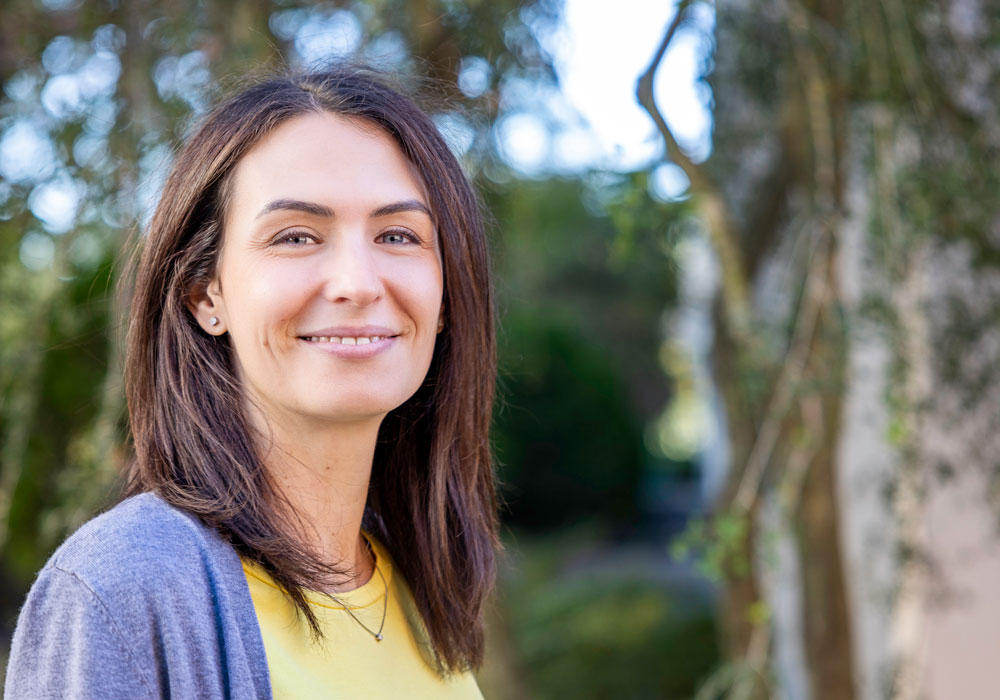Growing up on the Italian island of Sardinia, Alessandra Porcu sometimes fantasized about becoming a forensic detective — solving murders and other crimes by analyzing DNA like the detectives she had seen on TV.
“I have this strong curiosity, I always want to ask questions,” says Porcu, who joined the University of South Carolina’s College of Pharmacy this summer as an assistant professor. “I also loved to do jigsaw puzzles, to put things together and see all of the pieces become a whole.”
The detective fantasy faded by the time she started college, of course, but the fascination with solving puzzles persisted. She ultimately earned a Pharm D. degree from the University of Cagliari in her native Sardinia and a Ph.D. in Neuroscience from the University of Cagliari and University of Basel, in Switzerland, where she studied the pharmacology of cannabinoid receptors in the brain circuit regulating mood.
But while her neuropharmacology research satisfied her curiosity for a time, she sought a more challenging puzzle. “I wanted to apply what I was learning on neuropharmacology to something more, something bigger, like understanding how the environment affects the brain and regulates mood.”
She found what she was looking for at the University of California San Diego, in the Department of Psychiatry, where she studied how stress affects circadian rhythm in reward-related areas of the brain regulating mood. A Pathway to Independence Award from the National Institutes of Health funded two years of her postdoctoral research training in a technique called fiber photometry, which she used to study the effect of nighttime blue light on circadian rhythm and neuroplasticity in anxiety disorder.
Now, Porcu has brought her research interests — and her award, a $750,000, three-year NIH grant — to USC’s Department of Drug Discovery & Biomedical Sciences, where she is observing neuronal responses to blue light at night in the amygdala of adolescent mice.
The process involves attaching tiny fiber cables to the brains of the mice and then watching as neurons light up in response to various stimuli. It’s a painless procedure — “There are no pain receptors in the brain,” she says — but it has the potential to help develop new compounds for the treatment of anxiety and inform the prevention of mental disorders in humans.
"I wanted to apply what I was learning on neuropharmacology to something more, something bigger, like understanding how the environment affects the brain and regulates mood."
By understanding the mechanisms at work in mice brains, she says, we might learn something about how blue light, such as the light we subject ourselves to when we stare at our phones and other screens at night, affects circadian rhythm and neuroplasticity in our own brains. She is also interested in how such light contributes to negative outcomes, particularly among adolescents.
“You can flash blue light at humans and, using an fMRI you can see brain regions that are activated,” she says. “One study has shown that the blue light activates the amygdala, which is the center of emotion. That’s why I’m studying anxiety.”
In addition to exploring the potentially harmful effects of light on circadian rhythm, Porcu also hopes to improve our understanding of the relationship between circadian rhythm and the body’s responses, positive and negative, to various drugs.
“My idea is that if we understand how light affects our brain, we can improve the pharmacology of drugs because a lot of protein receptors are controlled by circadian rhythms. If light affects those rhythms, light can affect the efficacy of those drugs,” says Porcu. “We can, for example, choose the best time of the day when the drug is administrated.”
Porcu gets excited about her lab’s potential contributions to both mental health and the field of chronopharmacology, but she isn’t strictly a research junky. She is also excited to teach at USC — and not just because she enjoys sharing her knowledge with students. Explaining the field to students also helps her refine her own knowledge of a fast-evolving field.
“If you don't understand something, try to teach it — because you have to go deep to simplify,” she says. “Or as my favorite professor in Italy used to say, if you cannot explain it well, that means you didn't understand it well yourself.”
